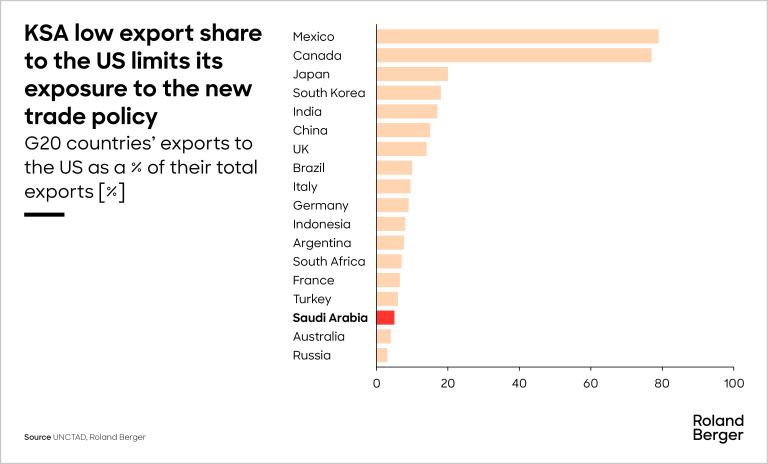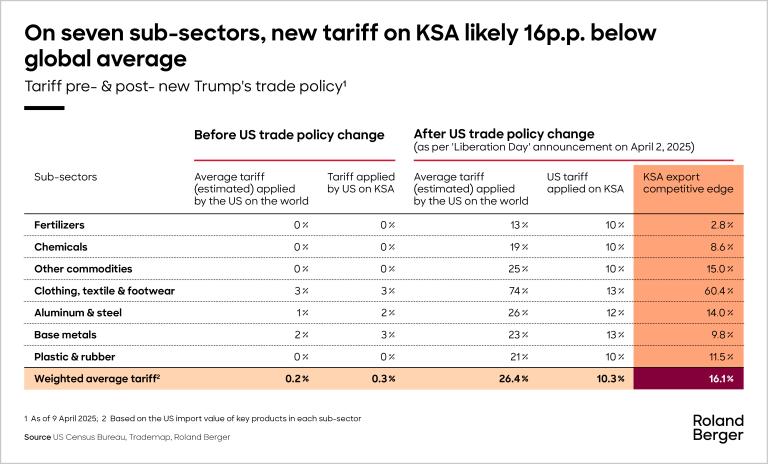

Understanding the U.S. trade shift: Opportunities for Saudi Arabia
Trump’s new trade policy is disrupting global markets — Saudi Arabia may have an “opportunity moment”
The return of the Trump Administration to the White House has brought a renewed focus on trade policy as a key lever of driving U.S. economic policy. With lightening speed since inauguration it is clear the Trump Administration is using tariffs as a way to reduce the U.S. trade deficit, renegotiate all trade relationships, and enforce the reshoring of manufacturing and production wholesale in the U.S. While this presents challenges for countries with high exposure to U.S. trade measures, Saudi Arabia (KSA) may find itself in a unique place to open up quickly new avenues for trade growth.

Where Saudi Arabia Stands
While Saudi Arabia exports a variety of products—including industrial and chemical goods—to global markets, its reliance on the U.S. is low both in terms of its share of total exports and compared to other G20 countries.

This lower exposure, combined with the Kingdom’s ongoing investments to diversify its economy and rapidly expand its industrial capacity, creates an opportunity for deeper commercial engagement with U.S. buyers seeking diversified supply chains or lower-cost alternatives following the tariff increase. Roland Berger’s analysis highlights several product categories—beyond fossil fuels—where Saudi Arabia could increase exports to the U.S. and gain market share. Following the recent April 9 trade policy change, tariffs on Saudi goods in these categories are expected to be around 16% lower than the global average (as of Apr 9 2025).
- Fertilizers – specifically Diammonium Phosphate
- Chemicals and other commodities – specifically P-xylene
- Clothing, textile & footware – specifically woven fabrics of synthetic filament
- Aluminium & steel – specifically alloy plates, sheets, and strips (>0.2 mm thickness)
- Base metals – specifically unwrought titanium and titanium powders
- Plastic & rubber – specifically Ethylene-propylene

The current U.S. trade policy positions are highly dynamic and are likely to continue to be so in the short-term. Nonethelss, KSA can take advantage of the changed global trade state-of-play with the U.S. to:
- Capitalize on the Kingdom's emerging position as a cost-competitive trading partner (given its low expected tariff vs. global average) to the U.S. to attract new sources of FDI in localized manufacturing and industrial development
- Position KSA as a key trade partner for U.S. based companies seeking reliable, cost-effective sources for goods and services
- Enhance B2B engagement through expanded trade promotion events and commercial outreach initiatives
- Sustain investments in the Vision 2030 localization agenda to strengthen industrial capacity and workforce skills, supporting future export growth
Conclusion
The results of this ongoing reordering of global trade driven by the U.S. is resetting business-as-usual that has organized supply chains and markets for several decades. For Saudi Arabia, this upheaval could result in an acceleration of its national development goals and the leap-frogging of its industrial base as a diversified source for exports to the US and other major global markets.



